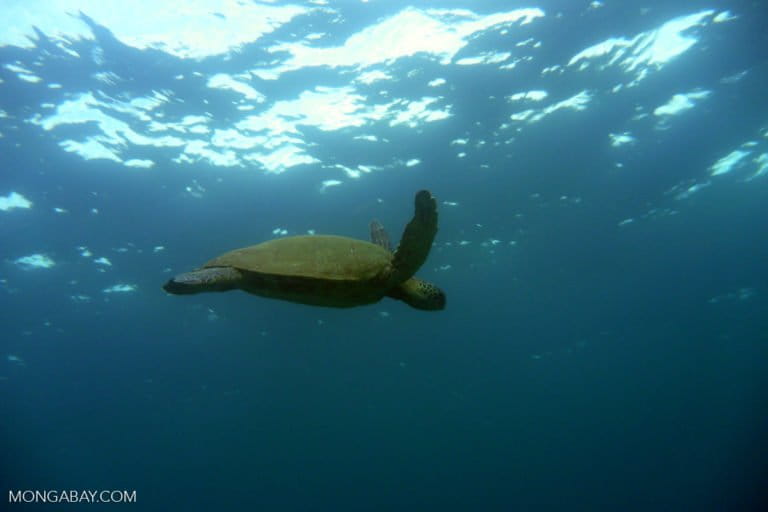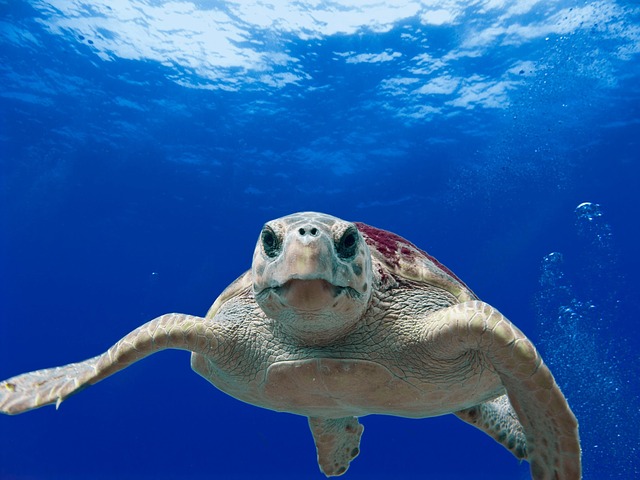By Johnny Langenheim
DENPASAR, Indonesia — A recent spate of busts has placed Bali in the spotlight once again as a key domestic market for endangered sea turtles. In February, Bali marine police officers confiscated 600 kilograms of butchered green turtle meat from a truck that had travelled from Madura Island to the resort enclave of Kuta. Last month, local news agency Detik reported that police had raided a warehouse in Gianyar, central Bali, where they discovered three green turtles, two of them still alive. In both instances police believed the turtles were being traded for their meat.
Indonesia — along with neighboring Coral Triangle countries the Philippines and Malaysia — is the major source market for sea turtles. Media attention often focuses on the lucrative international trade, but turtle meat and eggs are traditionally eaten by many ethnic groups across the archipelago country, despite the fact that catching wild turtles and trafficking them is forbidden here.
For the Balinese, turtle meat has long been a delicacy as well as playing a central role in religious ceremonies, making the Hindu-majority island Indonesia’s leading consumer of sea turtles. Demand is overwhelmingly for green turtles (Chelonia mydas), since unlike other sea turtle species, green turtles are not carnivorous, eating mainly sea grass, making their meat less fishy.

Indonesia implemented Law No. 5 “concerning the conservation of living resources and their ecosystems” in 1990 to try and stem the burgeoning trade in endangered species, including turtles. But in Bali, religious leaders were actively encouraging the ceremonial use of turtle meat, such as in the Yajña ritual, an important aspect of Nyepi, the Balinese new year.
Once Bali’s high priests and local politicians had been alerted to the problem, consumption of turtle meat in ceremonies dropped dramatically. “In 2005, the pedandas [religious leaders] issued a strict regulation on the use of turtles in ceremonies,” Suprapti said. Now, if communities wish to use turtle meat in a ceremony, they must obtain permission from the Hindu Dharma Council of Indonesia (PHDI).
The Balinese have a special dispensation to use turtles in ceremonies, but they cannot exceed 40 centimeters in length and must be obtained from the Turtle Conservation and Education Center, which the WWF helped open in 2006. The new measures worked: “Our research shows that in the last 10 years, no more than 100 turtles have been requested for rituals annually and in 2015 the number was just 48,” Suprapti said.
But the recent busts seem to indicate a significant surge in turtle trafficking to Bali. Last year, the island’s marine police and regular police force recorded eight smuggling incidents accounting for 171 green turtles — the most since 2001. And at time of writing, 2017 has already seen eight busts, according to Permana Yudiarso, from the Office of Marine and Coastal Resources Management in Bali. It’s not clear to what extent the increase is related to religious ceremonies or consumption outside the ceremonial sphere. According to marine police commissioner Sukandar, turtle meat fetches between 5 million and 7 million rupiah ($375-525) per kilogram. It is usually consumed as sate — meat on a stick.

“We think the increase in smuggling incidents reflects a combination of intensifying police action and higher demand,” Yudiarso said. “We’re also seeing a shift in smuggling techniques. Turtles used to come into north Bali by boat, but now they’re being butchered first and transported in trucks.”
Yudiarso doesn’t believe consumption of turtle meat is widespread, suggesting it is confined to southern Bali, the wealthiest part of the island. He also says the police are aware of food outlets selling turtle meat, but want to sting them at the right time, so they can catch the traffickers too.
According to the 1990 Conservation Law, trading in turtle meat is punishable by up to five years in prison and a 100 million rupiah ($7,500) fine. But WWF-Indonesia reports that the longest sentence ever handed down under the law is just two years. Enforcement in an archipelago that spans nearly 2 million square kilometers is also difficult to say the least. Bali may be the biggest market for turtle meat, but it is consumed in many other parts of Indonesia too.

The Wildlife Conservation Society (WCS) reports that communities in East Kalimantan, across East Nusa Tenggara, in Sulawesi, Java and Maluku all eat turtle meat and eggs. I’ve personally visited a community of the Bajau Laut ethnic group off the coast of Sulawesi where one household specialized in the processing and sale of turtle meat, quite openly. In such remote communities, enforcement is practically nonexistent.
For now, the main strategy of authorities in such areas appears to be education. Responding to the discovery of 38 captive turtles in the Aru Islands in the far east of Indonesia, Brahmantya Satyamurti Poerwadi, director general of marine spatial management at the fisheries ministry, said government efforts to protect turtles centered around socialization activities with local villages and schools.
Indonesia is home to six of the world’s seven sea turtle species and all of them are protected under Appendix 1 of the Convention on International Trade in Endangered Species of Wild Flora and Fauna (CITES), meaning none can be traded internationally. But according to the WCS, there remains a significant trade in hawksbill turtles (Eretmochelys imbricata), particularly for their shells which, once carved, can fetch as much as ivory in parts of China. They are smuggled along with species that can be legitimately exported.
In Java too, trinkets using sea turtle parts are also popular and it is easy to find stuffed green and hawksbill turtles in the area between the center and west of the island. The WWF estimates there are just 8,000 breeding female leatherbacks (Dermochelys coriacea) left in the world, placing the species on the brink of extinction.
Conservationists are pushing for harsher penalties for wildlife crimes against the backdrop of a marked increase in wildlife trafficking in general. At the end of February, Environment and Forestry Minister Siti Nurbaya Bakar announced that the government was in the process of revising the 1990 Conservation Law, describing it as “outdated.”
Strengthening the conservation law may act as a deterrent, but only if it is matched by enforcement, including increased fines. Lengthier prison terms are controversial – while they act as a deterrent it is feared they may turn offenders into hardened criminals. Said Yudiarso, “It’s important that we teach the younger generation about turtle conservation – that’s the way we can really stop the trade.”
Follow Johnny Langenheim on Twitter: @jlangenheim




